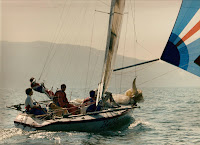Friday, November 20, 2009
Perception
Co-ordination, athletic ability and time in the boat/familiarity help in getting the head out of the boat and sharpening perception. If you have ever had the privilege to call tactics without having to worry about doing anything else on board you know how easy it is to be "smart" when you are able to look around full time.
Thursday, July 23, 2009
Tuesday, July 7, 2009
Organic Mint Tea

Tuesday, May 5, 2009
Simon´s Xs


Wednesday, April 29, 2009
Easy come easy go

Monday, April 20, 2009
Big Bang

Friday, April 17, 2009
Privilege

Sunday, April 5, 2009
Imagination

Thursday, April 2, 2009
Road Trip



Monday, March 23, 2009
T.I.B.

Wednesday, March 18, 2009
Caterpillar

Wednesday, February 11, 2009
Mothodology
.jpg)
Monday, February 9, 2009
Shark Again

Friday, February 6, 2009
Summer of 86
.jpg)
Tuesday, February 3, 2009
Ambrogio's Law
Thursday, January 29, 2009
Coffee and a Donut

Monday, January 26, 2009
Getting Around or How to Jybe

Friday, January 23, 2009
Thursday, January 1, 2009
Getting it Together

Moving on is the current paradigm but it´s a little weak in my books. To me life´s a puzzle - you don´t want to bin any of the pieces. Now is the time to take inventory of what I was dealt last year and to see where it fits in the big picture.
2008 was a season of remarkable achievements that didn´t come together to deliver many results. Notable exception: second place in the Open Belgian Snipe Championship with Floris.
What about all the rest: an amazing performance in the North Sea Race where the class divisions robbed us of a crushing victory over our on the water rivals; learning to sail and tune a Moth in virtual isolation; sailing an interesting season in the Snipe having swapped roles with Floris; doing tactics for a great crew on a Swan 70 in Sardinia; surviving the Moth Worlds. The one thing I´m proudest of is keeping us off the sand banks in front of Harwich in low visibility when the GPS failed. It was a short bright moment of getting it all together when it really mattered.




